See also:
Nikko Motor Bus Co. tour of Nikko, c. 1940.
“Writing lesson”, c. 1910.
Iroha-zaka [Iroha slope] refers to the road connecting Nikko to Lake Chuzenji.
The name derives from ‘i-ro-ha’ (‘zaka’ means ‘slope’), the first three of the traditional ordering of Japan’s 48 kana syllables used in the Japanese alphabet (the present-day syllabary has 100+ phonetic sounds) matching the mountain road’s 48 hairpin turns, each of which are marked by a hiragana character from the old Japanese alphabet. The characters start with the character line ‘i-ro-ha-ni-ho-he-to’ and continue in character groupings until ‘we-hi-mo-se-su’ as you ascend or descend the mountain, representing the complete order of the hiragana syllabary.
The ‘Iroha-uta’ is a well-known Japanese poem, the first record of which dates from 1079 CE. It is famous because the poem is a perfect pangram, containing each character of the 48-character man’yōgana syllabary exactly once. Because of this, it was used to determine the ordering for the base characters of the kana (hiragana and katakana) syllabary, in the same way the a-b-c-e-e sequence is used for ordering the Latin alphabet.
The first line of the poem, i-ro-ha-ni, can be translated as ‘Colors are fragrant …’
いろはにほへと
ちりぬるを
わかよたれそ
つねならむ
うゐのおくやま
けふこえて
あさきゆめみし
ゑひもせす
Colors are fragrant, but they
Will eventually scatter
Who in our world
Shall always be?
The deep mountains of karma —
We cross them today
And we shall not have superficial dreams
Nor be deluded.Map: Iroha-zaka, c. 1910. The series of switchbacks were originally a pilgrim walking path. Over time, the path was widened to allow for wheeled traffic – jinrikisha, early automobiles, etc.
- Map: Iroha-zaka, c. 1946. The two-lane switchbacks served as the only means of vehicular travel between Nikko and Lake Chuzenji until 1965 when a new up slope route was completed to the south.
- Map: Iroha-zaka, c. 2010. In 1965, a second set of switchbacks were completed from Nikko to Lake Chuzenji. Vehicular traffic now became one-way, up slope (south route) or down slope (north route).
In the Nara period (710-794 CE), Mt. Nantai, on the fringe of Lake Chuzenji, was considered a sacred mountain by both Buddhist and Shinto pilgrims and was long a place for mountain worship. After the Restoration, the lake became something of a summer resort after embassies from various foreign countries built summer villas around the lakeshore.
Up to that time, ascending the 400-meter difference in altitude between Nikko Town and Lake Chuzenji required portage on foot by palanquin [nonmono] or jinrikisha. In 1910, the Nikko Electric Tramway Co. opened a streetcar route from the town to Bechigurayama and then, in 1913, to Umagaeshi, the entrance to Irohazaka – the highest of all streetcar stations in Japan – dramatically shortening the walking distance between the town and the lake. From Umagaeshi, a 6-mile road of easy walking switchbacks led to Chūzenji.
Shirakumo Falls, Lake Chuzenji, Nikko, c. 1920. One of 40+ waterfalls in the Nikko area, Shiraukmo Falls are located slightly downstream from the larger Kegon Falls on the Daiya River originating from Lake Chuzenji but viewable from the same riverside observation deck reachable from the original (now upper) circuit of Iroha-zaka. (Gift of J. Harper Brady Sr.)
As the number of tourists arriving to the area increased during the Taisho period, the route up to Lake Chuzenji was upgraded. Work was completed in 1925 on improvements allowing automobile and bus travel along a narrow (4m wide) gravel roadway to the crest. In 1952, the route was further upgraded – widened and paved into a two-lane toll road.
By the early 1960s, the number of automobiles and tourists continued to increase to the point of causing chronic traffic jams, especially during the popular fall foliage tourist season. In response to this situation, construction of an additional set of switchbacks was begun by the Japan Highway Public Corporation and completed in 1965 with the new roadway – ‘Dai-ni Iroha-zaka’ – only open to ascending traffic. Descending traffic uses the original roadway – ‘Dai-ichi Iroha-zaka’.
Both roads offer breathtaking views of the surrounding mountains and forests, while their serpentine nature offer some excitement and challenge to drivers navigating the many twists and turns.
- Nikko Motor Bus, Nikko, c. 1940. Two modified 1937 Japanese-manufactured Chevrolet “open buses” negotiate the sharp, hairpin turns of the Iroha-zaka, connecting Nikko with Lake Chuzenji.
- “Aerial Cable-car at Akichihira”, Nikko, c. 1940. The Akechidaira Ropeway reaches an observation deck offering views of Kegon Fall, Lake Chuzenji, and Mount Nantai, first opened in 1933.
“A full night’s rest at the Kanaya Hotel , near the red-lacquered ‘Divine Bridge’, restores the Pilgrims from their fatigue. After a hurried visit to the temples and the tombs of Toshogu, the posthumous deified title of Ieyasu, the first shogun of the Tokugawa dynasty, a start is made on the road to Chuzenji.
“The road is almost impassable, yet the journey is pushed on. The path is such that the automobilists are frequently compelled not only to halt but to work hard in clearing the way on which stones and earth have fallen from the crumbling of the mountain side by the action of rain and storm that lately made visit here.
“For six miles the car is driven up the narrow pass bounded on one side by a precipitous wall of earth and on the other by an open dale, till the riders are obliged to make an abrupt stop. A huge stone, weighing probably more than a ton, and lying on the midway, prevents any further progress; and the Pilgrims are forced to retreat.”
– “To Nikko on Motor-Car”, by The Editor, The Musashino, April 1912
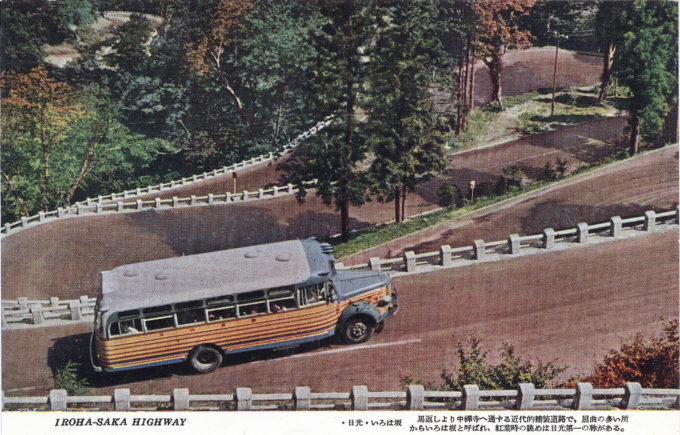
Iroha-saka Highway, c. 1960. The original sets of vehicular switchbacks, now called ‘Dai-ichi Iroha-zaka’, date back to 1925 with a major upgrade completed in 1952. Beginning in 1965, this roadway became restricted only to descending traffic. Back caption: “I-Ro-Ha” means the 48 Japanese letters. The switch-back mountain pass has as many curves as them.”


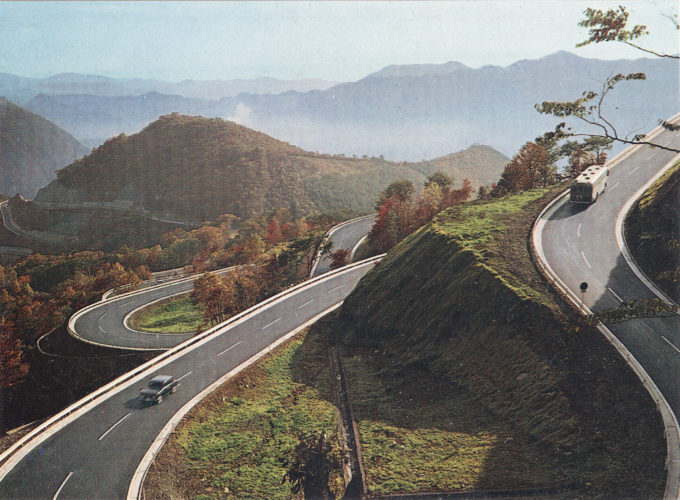
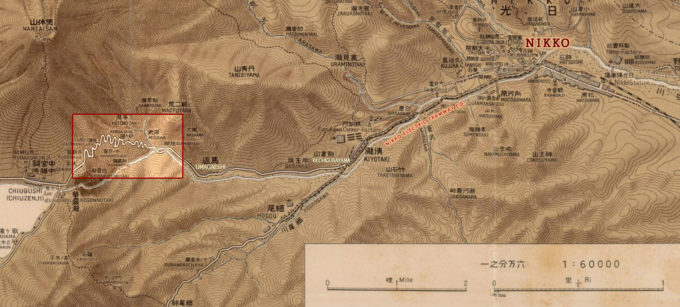
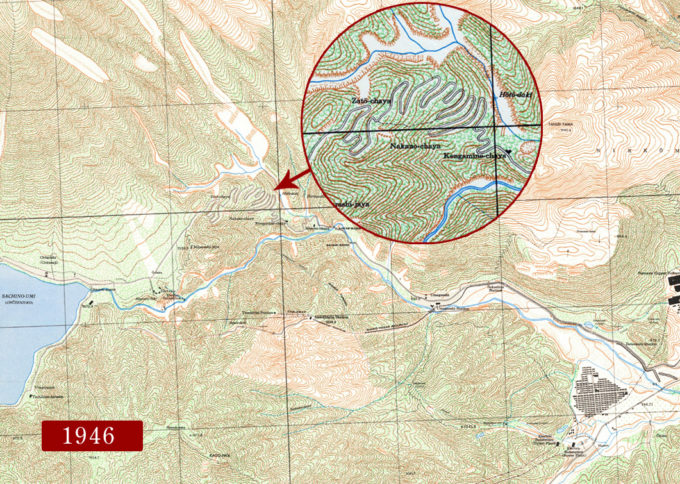
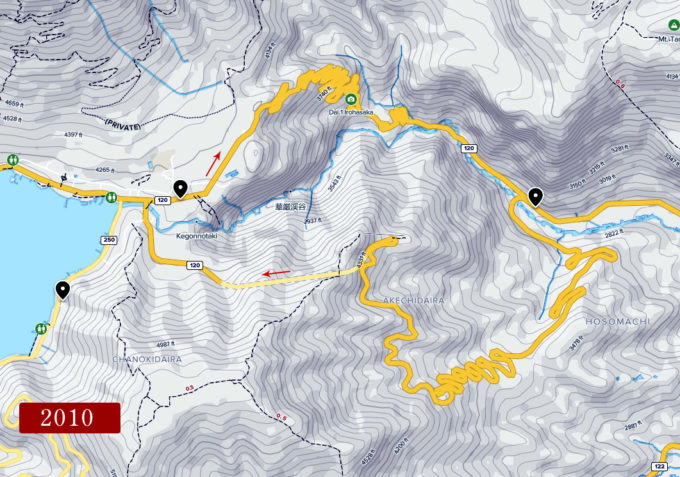
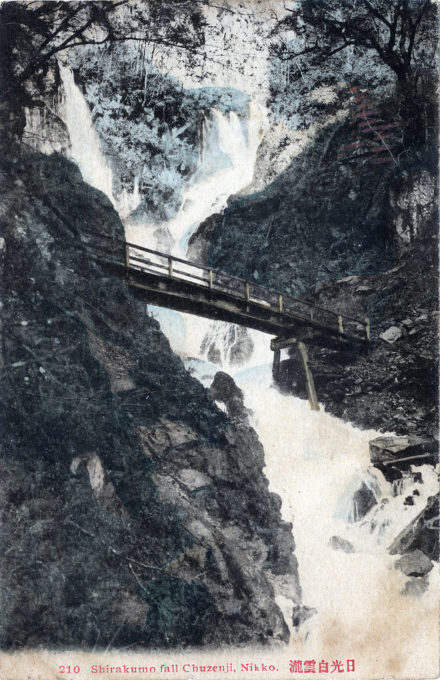
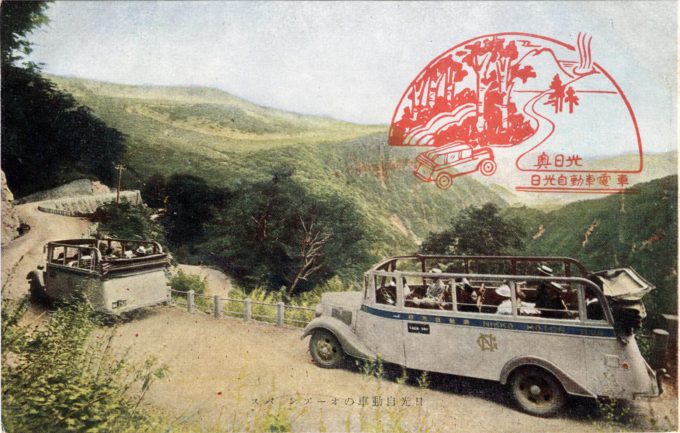
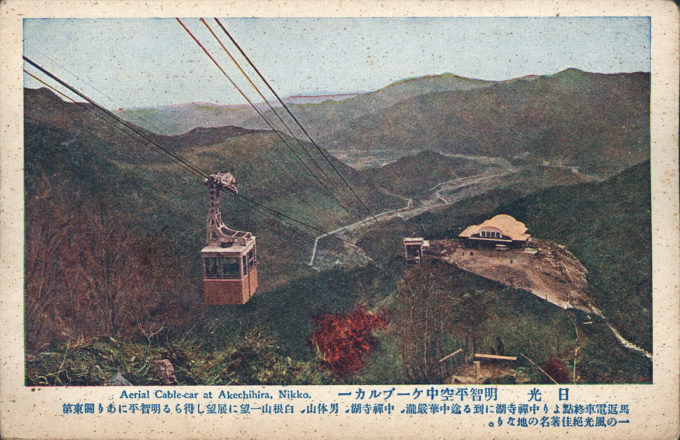
Pingback: “Writing lesson”, c. 1910. | Old TokyoOld Tokyo